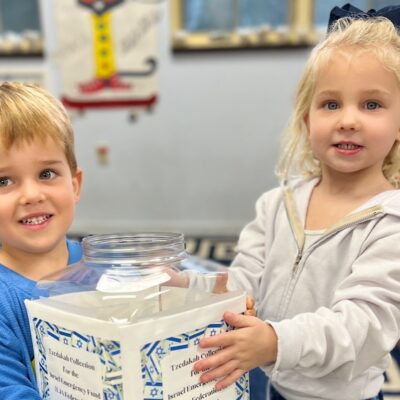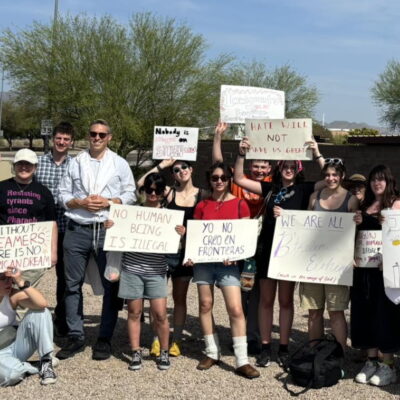Q&A
Amid generational shifts in giving, Jewish groups need new types of engagement, fundraising consultant says
Latest Giving USA report shows donations to religious causes shrinking, requiring Jewish organizations to find new ways of being relevant while building up endowments to retain viability

Courtesy/The Community Synagogue
Preschool students Shaina and Zeke, both 3, proudly hold the tzedakah jar for their friends to add their Shabbat donations. Funds were donated to the Israel Emergency Fund - UJA Federation of New York.
The annual Giving USA report that was released last month described a thriving philanthropic field, which saw a rise in inflation-adjusted giving for the first time since the COVID-19 pandemic.
The survey found that 2024 continued many of the existing trends in charitable giving, namely fewer donors providing more of the donations. The increase in giving was also not uniform, with some areas, such as public-society benefit and international affairs, seeing significant growth, while giving to religious causes — still the largest recipient — shrank by 1% when adjusted for inflation.
To understand what the Jewish community can learn from the report, eJewishPhilanthropy sat down on Wednesday with Avrum Lapin, the president of the Lapin Group, a fundraising and management consulting firm for nonprofits, who also serves as a board member of the Giving Institute, the organization behind Giving USA and its annual report.
The interview has been lightly edited for clarity.
Judah Ari Gross: One of the underdiscussed but likely profound issues in the Jewish communal world is the generational shift in philanthropic giving. How do we see that in this year’s Giving USA report?
Avrum Lapin: There are a couple of things going on. One is that Jewish giving was really counted in giving to religion. And giving to religion, if you look back 20 years, was at you know, 50%, 55%, 60% [of total charitable giving]. And now it’s 23%. And that’s against the backdrop of less affiliation — not just in the Jewish community, all over. And so I’m not surprised that the number has gone down, and it’s gotten picked up mostly by education and human services.
When we spoke last year, we talked about three generations: the post-Holocaust, the baby boomers and Gen Xers, who are currently in positions of leadership, the 45-to-60-year-olds. And now we need to account for the millennials, who are beginning to appear.
Young Jews are not the same as the previous generation. They’re not committed to Jewish institutions in the same way. They’re not committed to Israel in the same way. I think we saw it when many in that younger cohort who had gravitated back to the community kind of stayed on the sidelines during and in the aftermath of Oct. 7. And I think that is a big challenge for the Jewish community as it looks forward. In the realm of philanthropy, we have to find ways to find ways to engage those millennials.
In their parents’ generation, and it’s the same going back, they gave to Israel, gave to the Jewish community first, and only then gave to everyplace else. From Gen X, that went away. Giving to the Jewish community, giving to Israel, giving to Jewish causes was one item on their philanthropic menu. And they are a very generous generation. Obviously, you see the giving continues to grow. So the case needs to be made. We need to find a way to create paths of affiliation, paths of connection of engagement for young families.
Synagogue affiliation may or may not be the thing. The traditional way of Jewish federation young leadership programs may not draw people in the same way as they did.
In September 2024, the Generosity Commission, which was commissioned by The Giving Institute in 2021, dealing with this issue of the next generation. And interestingly enough, the rising generation of millennials, in particular, was motivated by social justice. They want to see impact from their giving. They want to see the results of the giving. And so that the notion of belonging to a community and being an individual donor in a community is different. And I think that the attention that needs to be paid to the emerging generation is different than it was for the generations before.
I think that the aftermath of Oct. 7 has shined a light on some of the fissures in the Jewish community and the need for the community to bring new solutions to the table rather than just the old prescriptions.
JAG: Regarding that generational divide, is the right move for organizations to try to make that pitch to this younger generation or should they also be hedging and trying to lean in more to the older generation to say, “If you don’t give us money now, we’re not going to survive another 10, 20, 30 years,” and to try to set up stronger endowments. Obviously, you can do both, but if the older generation still has that commitment, should the focus be on maintaining viability?
AL: We’re seeing on the ground level a little bit more attention to endowments. Local institutions are thinking more about endowments, less about buildings. There are fewer people going into synagogues, fewer people going into different places, and so the need to expand buildings and to build those buildings is diminishing. You want to renovate them, keep them attractive, keep them inviting, but at the same time, it’s less about building them than about sustaining the institutions themselves. And so there’s a little bit more attention now on endowment than there was perhaps before COVID and before Oct. 7.
But there’s no organized activity of “Well, we need to build up institutional endowments.” I think organizations are coming at it on their own.
It needs to be, in my mind, a priority to say that “Yes, immediate needs obviously are important. You need to keep the lights on and people paid. But you also need to think about the viability and the strength of the community going forward.”
It’s not a given that the institutions in the Jewish community will be as strong as they might be now or as strong as they were five years ago, or, I guess, six years ago before COVID. And so that’s a challenge for us. And that’s something I think that organizations should be looking at, and not just saying, “Well, we want to make our bank account bigger than it is now.” You need to give it some thought. What’s your vision for the future? What value do you bring to the American Jewish community or to the North American Jewish community that will be valued, that will be seen as something important? That will make a difference going forward. And how do you then package it, communicate it, relate it, raise money around it, and make sure that the future is at least to a certain degree secured.
JAG: Donor-advised funds don’t really appear in the Giving USA report, despite their growing prevalence. Are there other trends that are potentially missing from the data that Jewish resource development professionals should be aware of with the breakdown of individual giving versus foundational giving?
AL: There was a fear when donor-advised funds exploded in popularity several years ago that people were kind of banking their philanthropy. Since they don’t have the same allocation or distribution requirements as family foundations that you were going to see a decrease in giving. And you actually didn’t. Giving from donor-advised funds has been as robust as ever. You don’t get any sense that money’s being held back.
And I think that once [DAFs] become a regular part of the ongoing reporting… you’ll see where the essence of Jewish giving is, and it’s more in terms of giving from individuals.
The JFNA Israel Emergency Fund, [launched] after Oct. 7, almost entirely came from individuals — specifically individuals of a certain age. I think if JFNA were to try to do that again, they would run into generational issues, even in just the two years that have passed.
I think that the lines may have blurred a little bit [in terms of the sources of charitable gifts] just because of the way people are giving, but it’s still largely motivated by the vision and passion of individual donors.
JAG: One of the trends that has been around for years but is clearly getting stronger in this year’s report is that more money is being given by a smaller number of wealthier people. On the other hand, one of the larger grantmakers in Israel is the International Fellowship of Christians and Jews, whose funding overwhelmingly comes from small donations from large numbers of people. So clearly that model can also work.
AL: And you see it on the political side as well. You had [Sen.] Bernie Sanders [I-VT) in two campaigns, and [President] Donald Trump in the second campaign, not so much the first, drawing these small gifts from massive amounts of people. What did Bernie Sanders say? The average gift is $27 or less?
And yet that’s not carrying over into philanthropy. The philanthropy is still concentrated, and it’s a self-fulfilling prophecy. If the preponderance of your money is coming from a small amount of people, you spend less time on the bottom-up, more time on making sure that you get those major gifts because it’s a competitive arena. It’s fewer people, everybody’s knocking on their door, so that becomes the same cycle.
JAG: But are you aware of any initiatives within the Jewish community to change that, to send out mass mailers to everybody soliciting donations for $18? Or is that just passe?
AL: A lot of organizations are trying to do things that are fun, saying “You don’t have to give to come. Just come and have a good time and have a drink and network and so on.” But again, that’s kind of taking the old model and projecting it forward.
And there are small organizations, like there’s an organization here in Philadelphia called Tribe 12. They’re looking to engage Jews in the work of the Jewish community. And there needs to be more initiatives like that and less of the legacy organizations trying to create a new “Birthright” for millennials. And I say that with love and respect.
But it’s important to do something different, not just to try to attract young people to do the same. People are looking for connectivity. Somebody who’s 30 years old today or 35 years old today grew up in a world that was a lot different than their parents. They need to connect and they need to feel a part of something. And it’s not there in the same way as it was for their parents. And just offering them a place to come and have a drink is nice, but it’s a one-off. They need to be part of a community. They need to be part of something that functions and is alive. Just like the prior system or the existing system was for their parents, going back one to two generations. It was a place to go. It was a place to be. The synagogue was a community. Federation was a community, and not so much anymore. So we need a community that reflects and meets the needs and expectations of younger people as they’re looking for some way to connect.













